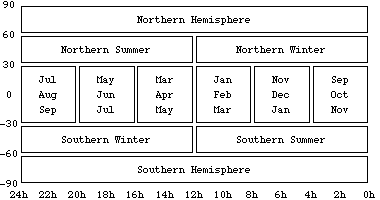|
Twelve Regions
You can divide the celestial sphere into twelve regions of roughly equal area, by the following procedure:
First divide the equatorial zone (between -30 and +30 degrees of declination) into six equal regions. All the planets and the Sun and Moon move along these regions.
Next divide the northern zone (between +30 and +60 degrees of declination) into two equal regions. Similarly divide the southern zone (between -30 and -60 degrees of declination) into two equal regions.
Finally the north polar cap (with declination greater than +60 degrees) and the south polar cap (with declination less than -60 degrees) form the last two regions.
Mapped in ascension/declination coordinates, the twelve regions are arranged as follows.
twelveRegions[];

Inside each region we have labeled the time or place when the region is dominant in the sky at night. Remember each region of the sky has a time of the year when it is well placed for viewing at night.
Having divided the sky into these twelve regions you can list all the interesting objects (such as dominant constellations, bright stars, good galaxies, nebulae, and clusters) that live in them.
Three or four of the regions will together contain all the objects that will be well placed in the night sky during any given month of the year.
For example, suppose you live in the northern hemisphere, and you want to know what objects will be viewable at night during the month of December (which is Northern Winter). Look under the sections "Northern Hemisphere", "Northern Winter", and "Nov/Dec/Jan" to find out. You might also want to look under some adjacent regions too, just in case.
|